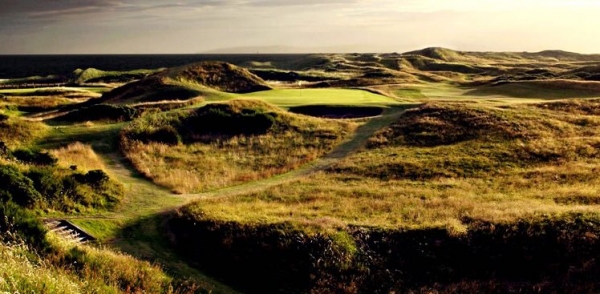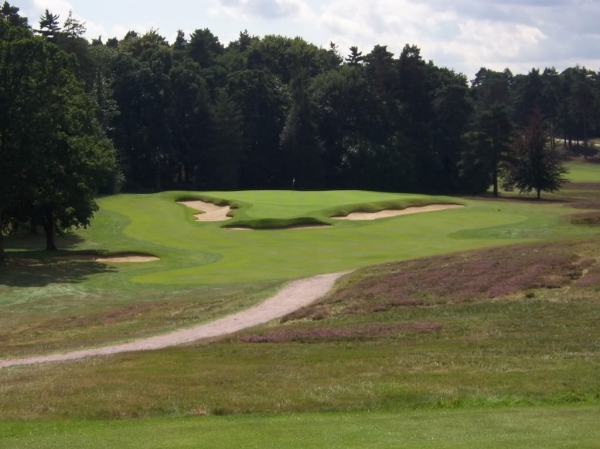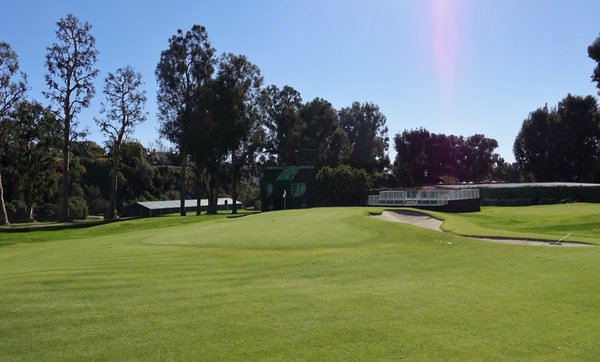Does Size Really Matter ????
Maybe the title got your attention
…
Just talking golf holes here - mainly the short-ish ones… especially the 4’s under 340 yards and the 3’s under 120 yards. And when I think of some of the best I’ve played… and a few that I’ve designed… it’s these shorter ones that always seem to be the most adaptable – and they have all the most distinct personality and playing qualities. Why? Maybe because they are so seemingly benign on the scorecard… or visually attackable from the tee. They may seem easy enough for sure, but the best short holes have options… and options produce the most enticing, memorable, sometimes most unpredictable golf experiences!
 Royal Troon's "Postage Stamp" is 123 yards of pure hell.
Royal Troon's "Postage Stamp" is 123 yards of pure hell.
Most of the greatest golf courses have em’. Think Riviera’s 10th, Royal Troon’s 8th, the 7th at Pebble Beach, the 18th at Inverness and Oakmont’s 17th. And how about the 12th at St. Andrews, the 10th at Merion or #9 at Cypress Point? Those are just a few of the holes that most are likely to identify with… but the one thing that screams out to me is this: ANYBODY can score on a short hole … but under pressure, these holes can cause the VERY BEST players to come completely unglued.
 The short par-4 4th at St. Georges Hill - 277 yards and a seemingly simple test? In my work, I see thousands of golf holes and work with plenty of guiding committees. We spend a good bit of time assessing how to make holes better and more enjoyable to play. What amazes me though, is the number of short holes that, over time, have been modified on courses for the purpose of adding length. Call it ego, call it selfishness of a few, call it competition among clubs… whatever the reason - it’s narrow-minded and a shame. Instead of stretching out long holes to be slightly longer, all too often the decision is made is to gain length by modifying the short holes. Not only does this approach often produce a poor fit of a hole (due to terrain, green size, etc.) but there is also the loss of the strategic short test that otherwise provided variety and demanded a different approach.
The short par-4 4th at St. Georges Hill - 277 yards and a seemingly simple test? In my work, I see thousands of golf holes and work with plenty of guiding committees. We spend a good bit of time assessing how to make holes better and more enjoyable to play. What amazes me though, is the number of short holes that, over time, have been modified on courses for the purpose of adding length. Call it ego, call it selfishness of a few, call it competition among clubs… whatever the reason - it’s narrow-minded and a shame. Instead of stretching out long holes to be slightly longer, all too often the decision is made is to gain length by modifying the short holes. Not only does this approach often produce a poor fit of a hole (due to terrain, green size, etc.) but there is also the loss of the strategic short test that otherwise provided variety and demanded a different approach.
When we consider that most of the great architects of the Golden Age believed so strongly in variety and in purposely designing short holes, then why have so many of them disappeared? I visited a course recently, designed by a noted architect back in the 1920’s. Today, the shortest par-4 hole on the course is 370 yards! When I looked back at the old aerial photos, there were two holes that were originally under 330 yards. I was told that those holes were lengthened in the ‘70’s to make the course more challenging and then again in the ‘90’s as the club was vying to host a state amateur event.
Let’s be clear… the total length on the scorecard is entirely irrelevant unless the course is too long. Some won’t want to hear that – but it’s their ego that is doing the talking. The most strategic and potentially dangerous holes are many times the shortest ones – the holes with the most options… AND, potentially, the most treachery. For the good golfers, length rarely makes a hole more difficult… it’s more often the subtleties and the cup location!! And if the length of the hole is such that it forces players to make critical club choices, or if they are in-between clubs… ALL THE BETTER.
So, the next time you see a short hole on the card and begin salivating about the birdie you’re about to make, be sure to take a second look before hitting your tee shot. There might be a whole lot more to consider than you think. Just watch the pros this weekend at Riviera! A mere 315 yards of brain drain for the best golfers in the world. They have more than a few options from the tee, but the green is devilish because of its size & depth and how it is angled against the line of play. And as I like to point out, the difficulty in that hole is what happens to the ball when it’s on the ground.
 Here's what the pros face on the 315 yard 10th at Riviera
Here's what the pros face on the 315 yard 10th at Riviera  What gets so many here is the tiny, shallow green Pete Dye has always claimed that once you give a good player options to consider, it’s way too much to think about… and then you’ve got ‘em!
What gets so many here is the tiny, shallow green Pete Dye has always claimed that once you give a good player options to consider, it’s way too much to think about… and then you’ve got ‘em!
So be sure to make time to watch the best in the world try to tackle Riviera's 10th during the Northern Trust Open - that will surely entertain.
Tags
Alister Mackenzie , Classic Courses , Course Design , Course length , Cypress Point , Enjoyable Golf , George Thomas , Golf Course Architecture , Golf Course Design Trends , Golf Course Improvements , Inverness Club , Making Golf More Fun , Merion , North American Courses , Old Course - St. Andrews , Pebble Beach , Pete Dye , PGA Tour , Renovation and Restoration , Riviera Country Club , Royal Troon , Short Par Fours , Short Par Threes , St. Georges Hill , Strategic golf , Strategic Options , Swinley Forest , Tournament Golf , Why Golf is Fun ,

Comments